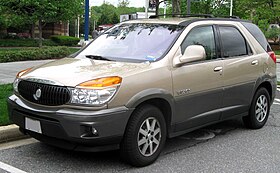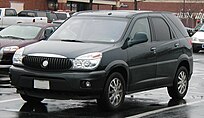Buick Rendezvous
This article needs additional citations for verification. (April 2010) |
| Buick Rendezvous | |
|---|---|
 | |
| Overview | |
| Manufacturer | Buick (General Motors) |
| Production | 2001 – July 5, 2007 |
| Model years | 2002–2007 |
| Assembly | Ramos Arizpe, Mexico |
| Designer | Elizabeth Wetzel (Interior) (1999)[1] |
| Body and chassis | |
| Class | Mid-size crossover SUV |
| Body style | 4-door CUV |
| Layout | Front-engine, front-wheel drive / all-wheel drive |
| Platform | U-body/GMT257 |
| Related | Pontiac Aztek |
| Powertrain | |
| Engine | 3.4 L LA1 V6 3.5 L LX9 V6 3.6 L LY7 V6 |
| Transmission | 4-speed automatic GM 4T65-E |
| Dimensions | |
| Wheelbase | 112 in (2,845 mm) |
| Length | 186.5 in (4,737 mm) |
| Width | 73.6 in (1,869 mm) |
| Height | 68.9 in (1,750 mm) |
| Curb weight | 4,024–4,272 lb (1,825–1,938 kg) |
| Chronology | |
| Successor | Buick Enclave |
The Buick Rendezvous is a mid-size crossover SUV that was sold by Buick for the 2002–2007 model years. Introduced in the spring of 2001, the Buick Rendezvous and its corporate cousin, the Pontiac Aztek, were GM's first entries into the crossover SUV segment. The Rendezvous featured a four-speed automatic transmission with a V6 engine and optional all-wheel drive (Versatrak). The SUV used the same platform as GM's short-wheelbase minivans, the Chevrolet Venture and Pontiac Montana. The Rendezvous provided a passenger- and load-carrying capacity not seen in the Buick lineup since the discontinuation of the Buick Roadmaster Estate station wagon in 1996.
Technology and notable features
[edit]
It was Buick's first truck in its lineup since 1923, and the Rendezvous was billed as a combination of the best attributes of a minivan (large cargo capacity, seating for up to seven), a luxury automobile (ride, handling, smoothness) and a sport utility vehicle (truck styling and available all-wheel drive).
The Rendezvous was produced at General Motors' Ramos Arizpe, Mexico, assembly plant, where it shared an assembly line with the Pontiac Aztek. Like the Pontiac Aztek, the Buick Rendezvous is based on a shortened version of GM's second-generation U-platform minivans. In lieu of four-wheel drive, the Rendezvous offered Versatrak, a full-time, fully automatic all-wheel-drive system which provided sure-footed traction in inclement weather and could handle moderate off-road surfaces.
Buick benchmarked its Park Avenue sedan as the prototypical target for ride and handling for the Rendezvous. To provide a luxurious and responsive car-like ride, all Rendezvous models came equipped with a fully independent rear suspension system with aluminum-alloy control arms and crossmember, as well as rear solid disc brakes, regardless of drivetrain.
The instrument cluster of the Rendezvous featured teal-illuminated needles and numbers set in a silver face accented by chrome trim rings that was meant to evoke the luxurious look and feel of an expensive watch or designer bracelet. On the uplevel CXL model, a driver information center on the instrument panel provided the outside temperature, compass, and a trip computer that included readings of fuel economy, driving range, and amount of fuel used; this was also available with the base CX model. An optional second-generation head-up display was also available on both CX and CXL models, while an optional tire-pressure monitoring system provided readings of tire pressure and warned if out of the specified range.
The Rendezvous boasted the ability to carry seven passengers when equipped with a third-row bench, a class-leading feature that Buick brought to market before its competitors, and was able to carry a standard 4-by-8-foot (1.2 m × 2.4 m) sheet of plywood.
In support of the Rendezvous's intended role as a versatile accoutrement for busy people with families, it provided a center console with storage space and power points for a laptop computer as well as separate compartments to hold a purse, a cell phone, pager, or other small items that the owner would want to keep organized and readily accessible as well as an optional rear cargo organizer system and rear seat stereo system controls with headsets.
Safety
[edit]The Insurance Institute for Highway Safety (IIHS) gives the Rendezvous an overall Acceptable rating in its frontal offset crash test for fair structure performance and fair dummy control. However, the IIHS did not perform a side-impact test on the Rendezvous.[citation needed]
Sales success
[edit]The Rendezvous was a badly needed success for Buick, given the decline of its aging customer base, and singlehandedly brought a large number of younger, wealthier "conquest" buyers into Buick showrooms who otherwise would not have considered purchasing a Buick. A major contributor to the Rendezvous's success was an aggressive value-pricing strategy that made the Rendezvous US$6,500 less than a comparably equipped Acura MDX and US$8,000 less than the Lexus RX. The Rendezvous handily exceeded GM's predictions of 30,000 to 40,000 units a year by a large margin, which helped offset the poor sales of its closest relative, the Pontiac Aztek.[citation needed]
Year to year changes
[edit]2003
[edit]- Optional rear-seat DVD system is now offered.
- Optional XM Satellite Radio is now offered.
2004
[edit]- Front turn signal/parking lights changed to clear from the previously used amber.
- The Ultra was added as a top-line model, with all comfort options standard, 17-inch aluminum wheels, leather and ultrasuede seating, and a theft-deterrent system.
- OnStar is now available on the Rendezvous as an optional feature.
2005
[edit]- The Ultra was available with front-wheel drive.
- The 3.6 L V6 was now an option for the front-wheel-drive CXL.
- Received chrome Buick tri-shield steering wheel.
- Leather-wrapped steering wheel is standard.
2006
[edit]- Quiet Tuning added to model.
- OnStar is now standard.
- Rear park assist is now standard.
- 3.5 L V6 replaces 3.4 L V6.
- Received chrome Buick tri-shield in grille.
- A black-faced instrument cluster replaced the all-silver one used in prior years (2005 in some models).
- Ultra dropped for CXL+.
2007
[edit]- OnStar Direction and Connections with turn-by-turn navigation.
- Available in CX and CXL trims.
- Available only in front-wheel drive with 3.5 L V6.
- Standard mahogany-trimmed steering wheel on CXL, optional on CX.
- Standard third-row seat on CXL trim.
- Last model year for the Buick Rendezvous.
Sales
[edit]| Calendar year | US Sales |
|---|---|
| 2001 | 31,754[2] |
| 2002 | 61,468 |
| 2003 | 72,643 |
| 2004 | 60,039 |
| 2005 | 60,589 |
| 2006 | 45,954 |
| 2007 | 15,295 |
References
[edit]- ^ "Elizabeth Wetzel". December 13, 2005.
- ^ GM US Data Book 2005 autointell.com/
External links
[edit]- Buick Rendezvous Official Web Page
- Buick Rendezvous from TopSpeed


